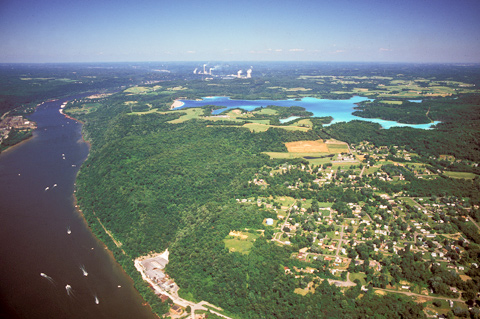At Georgetown, Pennsylvania, on 4 September 1803, Lewis paid eleven dollars for a leaky canoe “compleat with two paddles and two poles.” That craft, plus the pirogue he had purchased in Pittsburgh, were used as lighters to ferry some of the barge’s load over the shallowest riffles, so they wouldn’t have to offload ashore.
He and his skeleton crew of eleven men crossed the boundary between Pennsylvania and West Virginia south of the river, and Pennsylvania and Ohio on the north. With that, they officially entered the Old Northwest. The line, wrote Lewis, “is made visible from the timber having been felled about sixty feet in width,” and could easily be seen a considerable distance. It crossed the southernmost arm of Little Blue Lake, at extreme right and directly east of Lawrenceville, West Virginia, not far from the spot where Lewis and his crew may have spent that night.
Lewis couldn’t have seen the centerpiece of this photo, Little Blue Lake, because it was created 170 years after he passed by. In the early 1970s, a coal-fired generating plant near Shippingport began pumping a slurry of fly ash and water from its smokestack scrubbers into a settling-pond the company had created by damming and deepening the valley of a creek called Little Blue Run. The curved white shape at the north (left) end of the lake is the dam. The pure white fly ash settles to the bottom, leaving clear water above it, so the deeper parts are dark blue and the shallower areas lighter, which makes the impoundment resemble a tropical white-sand beach or a corral reef—except that no acquatic creatures can live in that chemical solution. As the lake fills up with ash, it is losing its neon-blue tint and turning into a pasty white sludge near its banks. Fly ash is now being reclaimed to manufacture drywall board.
In 1957, more than 150 years after Lewis stopped here, the first large-scale nuclear power plant in the world was completed at Shippingport, Pennsylvania, and went online in December of 1957, only fifteen years after Enrico Fermi (1901-1954) created the first atomic pile and the first controlled nuclear chain reaction. The first reactor at Shippingport was retired in 1982 and shipped to the Hanford waste disposal site in Richland, Washington, not far from the west end of the Lewis and Clark Trail. The water reactors plumed with steam above the center of the photo belong to the newer and larger Beaver Valley Nuclear Generating Station.
Georgetown, founded in 1793, was named for the city of the same name near the capitol, Washington City. In 1807 it consisted of about “thirty houses in a fine situation, on a narrow plain extending from the high river bank, to the hills which surround it like an amphitheatre.”[1]Sketches of a Tour to the Western Country, through the States of Ohio and Kentucky. Commenced at Philadelphia in the winter of 1807, and concluded in 1809, by Fortesque Cuming; Reuben Gold Thwaites, … Continue reading Through many ups and downs it has survived as an unincorporated community of 67 households with a population of 182 persons. It is situated in the vicinity of the three groups of white-topped freight barges moored at the south bank, north of the lake.
The river was so clear and shallow in September 1803 that Lewis and his crew could see “a great number of Fish of different kinds, the Stergeon, Bass, Cat fish, pike, &c.,” which prompted them to make some spears “after the indian method.” However, the captain concluded that they all “had too much to attend to of more importance than gigging fish”—such as manhandling the barge over the infernal riffles and shoals. It wasn’t until 1824 that Congress directed the Corps of Engineers to begin clearing some of the worst obstacles in the Ohio. The first dam was built in 1871 at Bellevue, Pennsylvania, just a couple of miles below Brunot’s Island (the site of Lewis’s first narrow escape). Next to come, beginning in 1885, was a series of 51 dams designed to canalize the Ohio first to a minimum six-foot depth, and after 1910 to a 9-foot minimum from Pittsburgh to the Mississippi. The segment of the Ohio pictured in this photograph is a lake created behind New Cumberland dam, 12 miles below Lawrenceville, which is one of the twenty high-lift dams built between 1908 and 1921.
The history of Lawrenceville goes back to 1714, when a trading post was established in the vicinity. The town was created by the Virginia legislature in 1814. The state of West Virginia seceded from Virginia and joined the Union in 1863.
From Discovering Lewis & Clark from the Air
Photography by Jim Wark
Text by Joseph Mussulman
Reproduced by permission of Mountain Press
Notes
| ↑1 | Sketches of a Tour to the Western Country, through the States of Ohio and Kentucky. Commenced at Philadelphia in the winter of 1807, and concluded in 1809, by Fortesque Cuming; Reuben Gold Thwaites, ed. (Cleveland, Ohio: Arthur H. Clark Company, 1904), 110. |
|---|
Experience the Lewis and Clark Trail
The Lewis and Clark Trail Experience—our sister site at lewisandclark.travel—connects the world to people and places on the Lewis and Clark Trail.
Discover More
- The Lewis and Clark Expedition: Day by Day by Gary E. Moulton (University of Nebraska Press, 2018). The story in prose, 14 May 1804–23 September 1806.
- The Lewis and Clark Journals: An American Epic of Discovery (abridged) by Gary E. Moulton (University of Nebraska Press, 2003). Selected journal excerpts, 14 May 1804–23 September 1806.
- The Lewis and Clark Journals. by Gary E. Moulton (University of Nebraska Press, 1983–2001). The complete story in 13 volumes.


